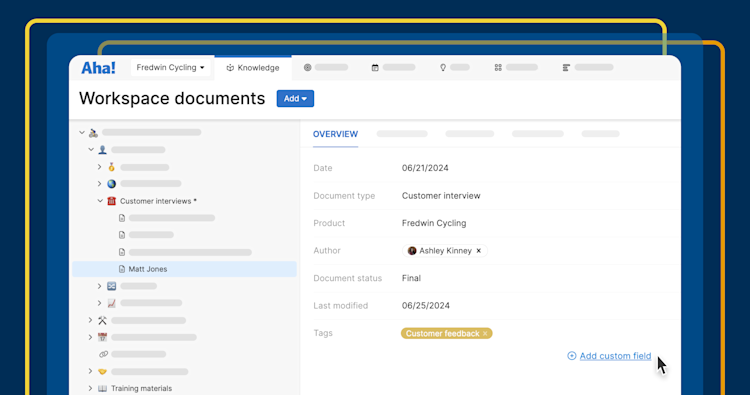
Dealing with document disarray? Try a purpose-built knowledge management tool such as Aha! Knowledge.
5 Aha! teammates share how we use our product knowledge base
What is the best method for sharing product information with cross-functional teammates? Positioning briefs, release notes, Slack messages — there are lots of ways depending on what you are sharing. (Just please do not use email. Nothing gets lost faster!) You want to ensure colleagues can absorb details relevant to their own roles and help drive product adoption. This is why we recommend consolidating everything in a shared knowledge base.
Build and publish a knowledge base for cross-functional teammates using Aha! Knowledge — so everyone can access what they need to support, sell, and market your product.
A knowledge base gives you one place to store the documents or tools that other teams need. For example, you might share process flows, deployment instructions, or troubleshooting tips. When resources are organized and accessible, folks spend less time tracking answers down or interrupting teammates for answers. (You know we love a good interruption, but not when the answer can be easily and independently discovered.)
With Aha! Knowledge, you can create as many public or private knowledge bases as you need for different audiences. Here are a few examples of internal knowledge bases:
Organizationwide: Accessible to all members of the company. These types of repositories might include documentation such as organizational charts, company goals, product positioning, strategic roadmaps, team charters, and information security policies. This way, anyone at the company can quickly access the essential information they need to follow company guidelines and align their team's work with top-level goals and initiatives.
Departments: Tailored to the needs of specific departments or functions. For example, customer support and marketing teams should have access to relevant customer personas, competitor insights, customer feedback, and any other information that helps them better serve customers and prospects.
Team-specific: Focused on individual teams within the organization. Examples of information in team knowledge bases might include meeting notes, team-specific initiatives, and brainstorming sessions.
We are unique at Aha! in that everyone uses our roadmapping software daily and has access to multiple knowledge bases. Teammates view docs via the Knowledge section of Aha! Roadmaps. (We use features such as tagging, to-dos, dynamic whiteboards, and templates to ensure information is shared across teams seamlessly.) This means no toggling between tools — we can easily transition from sharing knowledge to getting work done.
To give you a better idea of how we do this, we asked five Aha! teammates to provide examples of information they most frequently share or access in our internal knowledge bases:
Strategic planning
"As an organization, we set strategic initiatives every six months. Eventually, we add each one as an initiative record in Aha! Roadmaps. It is super valuable to brainstorm with teammates, jot down ideas, and record decisions within notes and whiteboards in a knowledge base during these planning periods. Using features such as to-dos and inline comments makes it easy for the team to follow along. Later, work on our roadmap is linked back to the initiative it supports along with any of the strategic planning docs that provide more context." — Mike Redd, marketing
Customer research
"Among many other things, we store customer interview templates in our product team's knowledge base. These help the team maintain consistency across customer calls. After calls, we use the AI assistant to summarize common themes from the feedback. I appreciate that I can manage permissions in the knowledge base so anyone in the organization can view the information, but only specific team members can edit it." — Austin Merritt, PM/UX
Helpful visuals
"I am a huge fan of whiteboards — they help me distill technically complex information that I get from engineering into something visual I can share with teammates in product, Customer Success, and marketing. I organize these flowcharts, diagrams, and wireframes into relevant folders in the knowledge base so people can find what they need, fast." — Jordan Kiga, PM/UX
Product launch plans
"Every launch is a team effort. And even though the details do change, some standard activities stay consistent across launches. So we use our knowledge base to store launch checklists and any details the broader organization needs access to. For example, we want to make sure teammates can quickly access updated product positioning, customer announcements, and links to support materials." — Amy Ellis, marketing
Product how-tos
"You asked about internal knowledge bases, but I would be remiss not to mention our public-facing customer knowledge base. I use it just as much as our internal tools and resources. It is a treasure trove of well-organized, clear information and serves as an invaluable resource for the Product Success team. We use it to find quick answers when we are on customer calls and to direct customers to where to find the latest product enhancements and how-tos." — Stephanie Lechner, Customer Success
Reject the typical silos of information sharing and elevate how the team works together.
A well-maintained knowledge base is more than a repository of information. It fosters collaboration and efficiency, and it is one way we live out our values as an organization. We are eager to help you do the same — tell us what you would like to see next in Aha! Knowledge.
The Aha! suite covers every step of the product development lifecycle so teams can create real value. Join a demo to see how.




